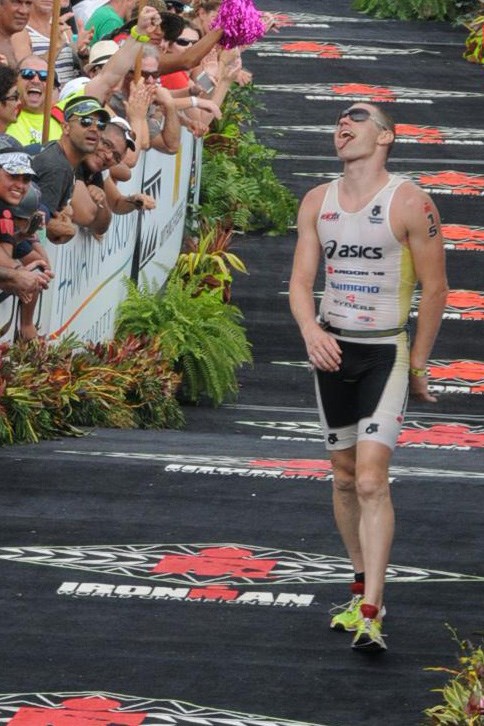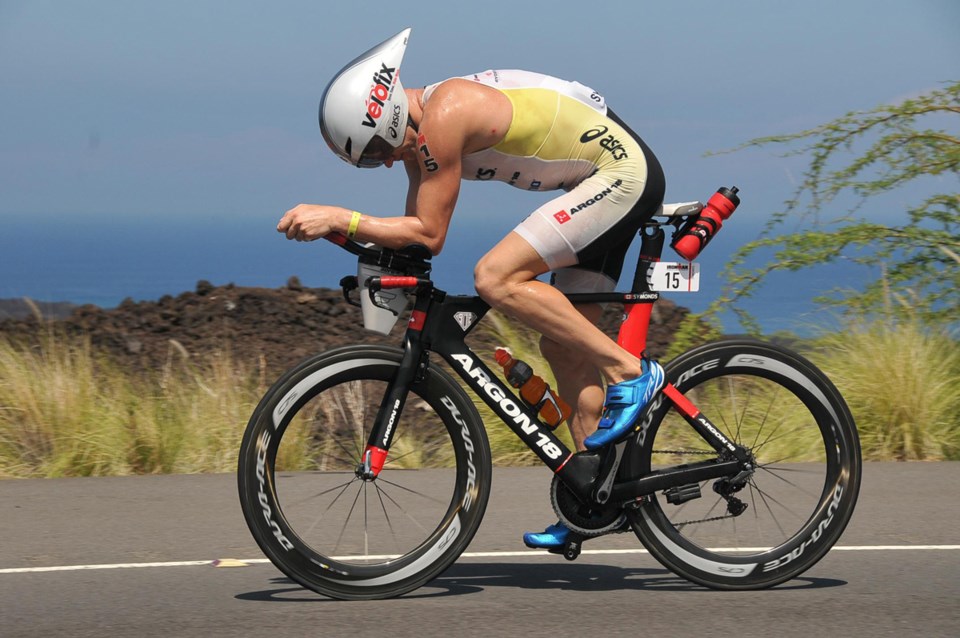He’d swum for almost an hour in the open ocean and cycled 90 kilometres in the Hawaiian heat and humidity. With another 30 km to go on his bike and then a marathon to run before the end of an eight-hour race, Jeff Symonds was put to an extreme test in the Kailua-Kona Ironman on Oct. 10.
His bike broke. The bolts came loose on the left crank, making the pedal unusable. He kept going.
“I had two choices,” said Symonds, “drop out or keep riding with one pedal.”
He noticed something was wrong roughly 65 miles (140 kilometres) into the ride.
“It’s important to keep your focus on purely what you can control, so I tried my best to put it out of my mind until the issue became a really big problem,” he said.
The problem got progressively worse until the crank was completely unusable. It had rotated 180 degrees so it was spinning with — not opposite to — the right-side pedal. There remained 18 miles (30 kilometres) until he transitioned into the run of the Ironman World Championship.
Toughest of all
“I thought about everyone else in the race and what it means to them and me just to get to the finish line. Not everyone is fortunate enough to race triathlons for a living and a lot of people have sacrificed a lot to get the opportunity to finish,” said the former UBC steeplechaser and Vancouver triathlon course record holder.
“I also thought about lots of people who were going to finish the race despite bigger adversity. Some competitors have serious disabilities. There have been people complete the race with only one leg, so I thought if I had to pedal with just one leg for a while, that isn’t so bad.
“I also wanted to finish for the learning.”
Mental game
Symonds was 94th overall after the cycle portion of the Ironman. After finishing the swim in 34th place, 60 competitors passed him on the 120-km bike ride. Remarkably.
Using one leg didn’t come with an excessive physical toll, but the Penticton-raised racer was exhausted in other ways.
“There was a bit more tension in my right leg from pedalling, but the bigger issues were mental. I had gone from being in a good position to execute the race that I wanted, to being well back of where I was. It was hard not to think about where I could have been and if I had the mental fortitude to push hard for the entire marathon.
“A marathon is a long way to go, especially after swimming 3.8 km and biking 180 km. It takes a lot of conviction to get that done and I was struggling a bit. I was also trying to get my nutrition back on track as it is really hard to take one hand off your handlebars to grab a drink bottle when you only have one foot on the pedals and the winds are howling. After the race, my right leg was significantly more sore and tight.”
Goonies never say die
Symonds posted a photo on Instagram taken from the start of the 42.2-km marathon. A woman is leaning in to talk with him while he holds his hands to his face.
He might have stopped if Sophia Chadwick, his fiancée, hadn’t been there to console and encourage him. Symonds told her his heart felt empty.
“She is amazing,” he said. “I didn’t know if I would have the drive to push hard for 26.2 miles. She was just telling me to just keep going and it will come later.”
Friends also motivated him from the sidelines. Sean Astin, an actor from the Lord of the Rings trilogy and 1985 children’s classic Goonies, was somewhere in the field of competitors that day. Symonds’s friends reminded him of this.
“One of my friends yelled out ‘Goonies never say die!’ It was awesome.”
Iron workers
No training can really prepare an able-bodied athlete to pedal with one leg. But athletes prepare themselves for obstacles just by setting out to attempt an Ironman, said Symonds.
“All of the training you do helps to build your toughness and ability to overcome setbacks. It does this by building your conviction to keep pushing hard. It takes a lot of hard training sessions to prepare for an Ironman.
“During that training you have good days and bad days. Getting though the ups and down of training is what gives you the strength to get through the ups and downs of racing. It also helps to be surrounded by others who have a great passion for hard work and never giving up.”

2:50:15
Once he set off, Symonds ran the third fastest marathon of all professional competitors.
His time of two hours, 50 minutes and 15 seconds came after nearly six hours of racing. For comparison, the Canadian men’s marathon record is 2:10:09.
“More than anything I just wanted to prove to myself what kind of character I had. I wanted to find out how hard I could push even if there wasn’t a top result of personal best to chase,” he said.
Symonds, who won the Ironman Asia-Pacific Championship earlier this summer, finished the world championship 23th overall.
“I want to prove that I stood for something more than that [a personal best]. I wanted to prove that I was someone who was going to ‘Get Ugly’ and keep fighting to the finish no matter what. I struggled getting my head sorted and finding new motivation on the first few miles, but it is a huge confidence booster heading forward to know that I ran the last 23 miles significantly faster than any other competitor.
“Only 51 weeks until next year’s race and I can’t wait.”
Twitter and Instagram: @MHStewart



